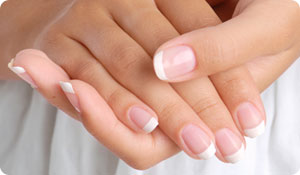
Whether you get regular manicures or never do more than give your nails a cursory cut, the fact is, they speak volumes about your hygiene and your health. Here are some ways to ensure that your nails stay strong as well as signs that a more serious medical condition is going on and look for these signs to detect a potential medical problem.
Your nails' appearance and growth rate relies on several factors including genetics, vitamin and mineral levels, and regular habits. When you eat poorly, bite your nails, or pick your cuticles, you put them at risk for splitting, breaking, or developing an infection.
In order to keep them healthy, you don't need professional help. Regular trimming and filing, hand washing and cleaning under the tips, along with simple cuticle care is all that you need. Polished nails can also be healthy, but just be sure to give them a day or two to breathe in-between polish applications. And be aware that polishes and especially polish removers can dry out nails. Try to limit remover use to twice a month.
Smart Steps for Routine Nail Care:
- Push cuticles back, DON'T cut them! Cuticles are there to protect your nail bed and without them, you risk infection. Rub moisturizing cream or petroleum jelly into the cuticles weekly to help prevent cracking or tears.
- Wear gloves when doing dishes, cleaning, or working with chemicals. These will not only protect your nails, but your hands, which are extremely susceptible to premature aging.
- Keep your nails short and somewhat square in order to avoid accidental tears.
- Don't use your hands as tools to pick at or open things.
- Bring your own tools for a professional manicure. Viruses, bacteria, and fungal infections spread very easily through tools, even when they appear clean.
Signs of a Medical Problem:
You'll notice that doctors often examine your nails during an examination. That's because nails can hold warning signs for serious medical problems. Some irregularities like white spots or vertical ridges are normal or indicate a minor trauma, but others can be more serious:
- Yellow discoloration can indicate an easily treatable infection, or can be a sign of a respiratory condition.
- Clubbing-when your nails curve around your fingertips-can indicate low blood oxygen levels.
- Soft, scooped or "spoon nails" may mean that you're anemic or need more calcium.
- Very white nails can be a sign of liver problems.
- Bright red nails may indicate heart problems.
- Grey or black nails may mean melanoma is present.
- Beau's lines-or horizontal ridges across your nail-can be also be a sign of illness.
If you notice any of these problems in your nails, don't panic. Many irregularities are caused by a fungal infection. Start with a visit to your doctor, who can determine if your problem can be cleared up with a simple cream or if it merits further investigation.
Source:
Osteopathic.org: "Make Nail Care Part of Your Health Routine." American Osteopathic Association. Web. 2011 http://www.osteopathic.org/osteopathic-health/about-your-health/health-conditions-library/general-health/Pages/nail-care.aspx





